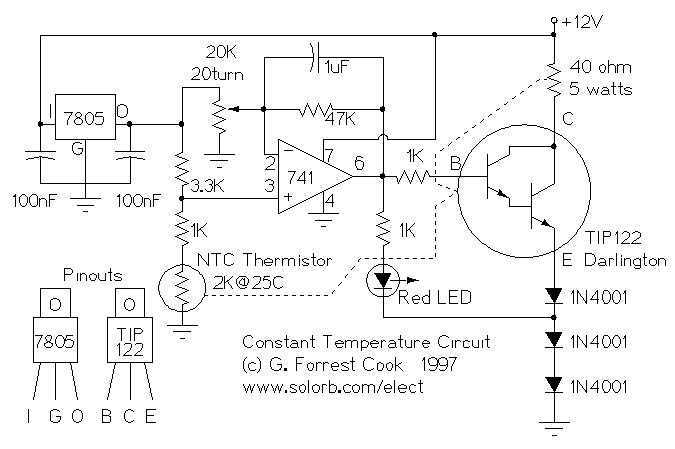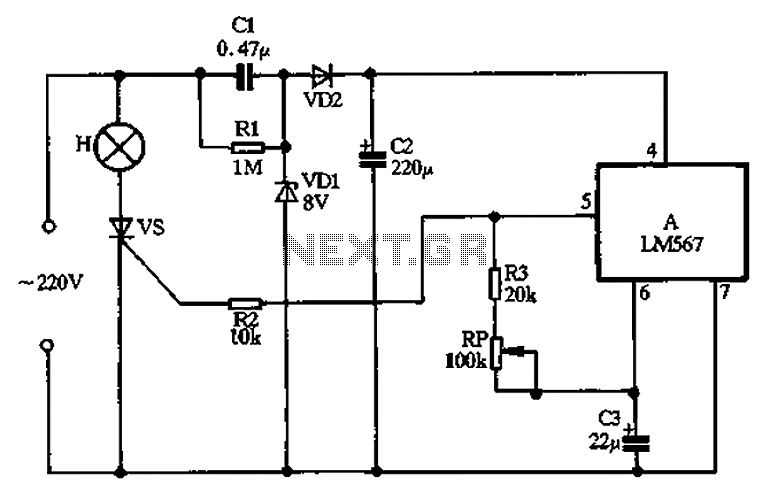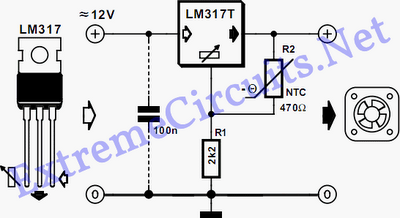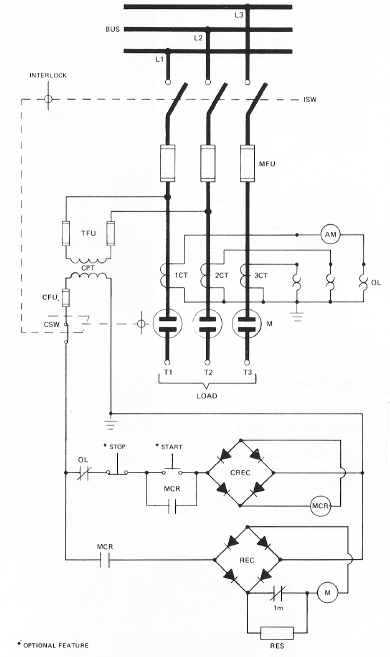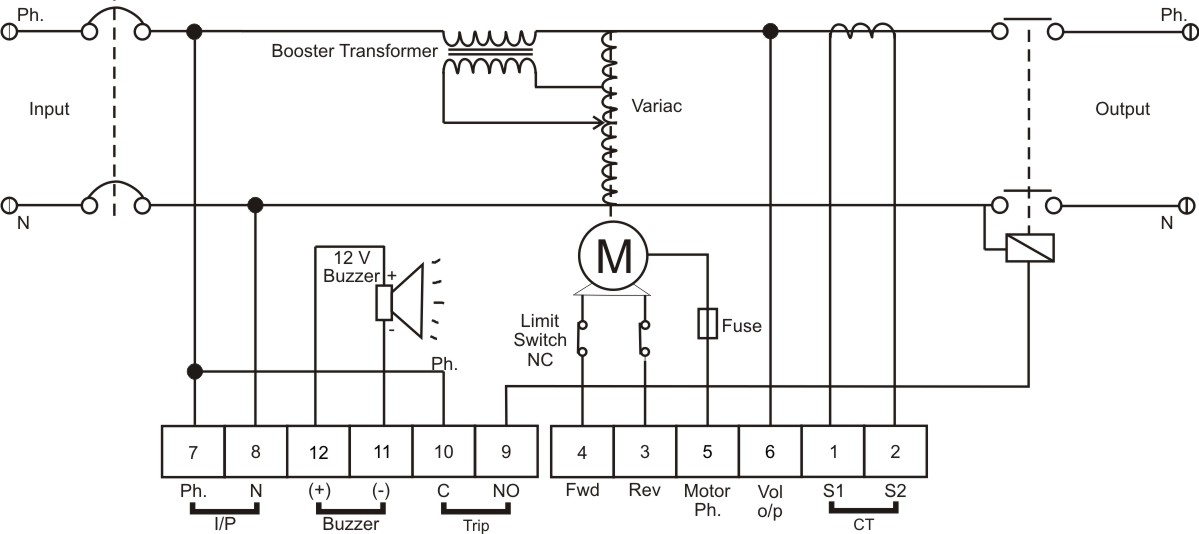
Disco Smoke controller
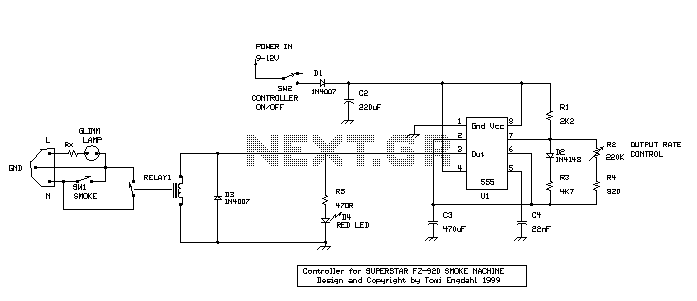
When the power is connected to the circuit by turning on SW2, RELAY1 gets energized for the time it takes to load C3 through R1 and R3. After that, the relay gets de-energized, and C3 gets discharged through R2 and R4. The setting of R2 determines the discharge time, which can be up to 1 minute. After C3 is discharged, the relay is activated. C3 charging starts again. The charging of C3 takes around 2 seconds. After that, the relay is de-energized, and C3 discharge starts again. Every time the relay is energized, the smoke machine is set to push out smoke. More: Some remarks of the remote controller wiring:
The use of the wires is quite non-traditional (ground pin used for other things than safety ground!). When the switch connects GND to the N wire, the smoke machine puts out smoke. When there is voltage between L and GND, the lamp in the controller (GLIMM lamp and resistor) lights to show that the fogger is heating up. Because of this special wiring, it is dangerous to connect anything other than the original controller to the fogger. It is potentially dangerous to connect this controller to a normal mains outlet because pressing the button will short one line wire to ground. But anyway, that was how the original product was designed. If the smoke machine were redesigned, it would have been done differently. If more information on the insides of the Superstar FZ-920 smoke machine is needed, a crude drawing of the circuits inside the FX-920 smoke machine is available. To make this circuit remotely controllable, a relay was added in parallel with the existing button on the controller and a circuit was made to control that relay. The time it puts out smoke is around 2 seconds, which is adequate to put out enough smoke fluid that the smoke machine emits smoke for a brief amount. The time between the smoke output is adjustable from practically constant smoke output to a one-minute pause between brief bursts of smoke. NOTE: The wiring of the controllers of the smoke machines can vary from manufacturer to manufacturer. The controller of a specific smoke machine might be entirely differently wired and might even use a different type of connector.
The described circuit operates as a timing mechanism for a smoke machine, utilizing a relay (RELAY1) to control the smoke output. Upon activation via switch SW2, RELAY1 is energized, allowing capacitor C3 to charge through resistors R1 and R3. The time it takes for C3 to charge determines how long RELAY1 remains energized. After reaching its voltage threshold, RELAY1 de-energizes, causing C3 to discharge through R2 and R4, where R2's resistance value dictates the discharge time, allowing for a maximum duration of one minute.
The circuit's operation is cyclical, with C3 charging for approximately 2 seconds before RELAY1 is de-energized again, leading to another discharge cycle. This cycle controls the smoke output from the smoke machine, providing brief bursts of smoke as RELAY1 activates the smoke machine when energized.
The remote controller's wiring is noted for its non-standard approach, particularly in using the ground pin for purposes other than safety grounding. When the controller's switch connects the ground to the neutral wire, it triggers the smoke output. Additionally, the controller features an indicator lamp (GLIMM lamp) that illuminates when there is voltage present between L and GND, indicating that the fogger is in a heating phase.
Due to the unconventional wiring, caution is advised against connecting any device other than the original controller to the smoke machine, as this could create hazardous conditions, such as short-circuiting the power lines. The design of the smoke machine emphasizes the need for a specialized controller, with variations likely existing among different manufacturers. The addition of a relay in parallel with the original button allows for remote operation, enabling adjustable smoke output timing from nearly continuous to intervals of up to one minute between bursts.When the power is connected to the circuit by turning on SW2, RELAY1 get energized for the time it get for it to load C3 through R1 and R3. After that the relay get de-energized, C3 gets discharged through R2 and R4. The setting of R2 determines the discharge time which can be up to 1 minute. After C3 is discharged, the releay is activated. C3 charging starts again. The charging of C3 take around 2 seconds. After that relay is de-energized and C3 discharge starts again. Every time the relay is energised, the smoke machine is set to push out smoke. Some remarks of the remote controller wiring: The use of the wires is quite non-traditional (ground pin used for other thing than safety ground !) When switch connects GND to the N wire, the smoke machine puts out smoke When there is voltage between L and GND, the lamp in the controller (GLIMM lamp and resistor) lights to show that fogger is heating up. Because of this special wiring is is dangrous to connect anything else than the original coontroller to the fogger.
It is potentially dangerous to connect this controller to a normal mains outlet, because pressing the button will short one line wires to ground. But anyway that was ho the original product was designed. If I were the redigned of the smoke machine, I would have done the thing a little bit differently. If you want more information on the insides of the Superstar FZ-920 smoke machine, take a look at my crude drawing of the circuits inside FX-920 smoke machine.
To make this circuit remotely controllable, all I had to do was to add relay on parallel with the existing button on the controller and make a circuit which controls that relay. The time it puts out smoke is around 2 seconds, which was adequate to put out enough smoke fluid that the smoke machine puts out smoke for a brief amount.
The iime between the smoke output is adjustable from practically constant smoke output to one minute pause between brief bursts of smoke. NOTE: The wiring of the controllers of the smoke machines can vary from manufacturer to manufacturer.
The controller of your smoke machine might be entirely differently wired and might even use different type of connector. 🔗 External reference
The use of the wires is quite non-traditional (ground pin used for other things than safety ground!). When the switch connects GND to the N wire, the smoke machine puts out smoke. When there is voltage between L and GND, the lamp in the controller (GLIMM lamp and resistor) lights to show that the fogger is heating up. Because of this special wiring, it is dangerous to connect anything other than the original controller to the fogger. It is potentially dangerous to connect this controller to a normal mains outlet because pressing the button will short one line wire to ground. But anyway, that was how the original product was designed. If the smoke machine were redesigned, it would have been done differently. If more information on the insides of the Superstar FZ-920 smoke machine is needed, a crude drawing of the circuits inside the FX-920 smoke machine is available. To make this circuit remotely controllable, a relay was added in parallel with the existing button on the controller and a circuit was made to control that relay. The time it puts out smoke is around 2 seconds, which is adequate to put out enough smoke fluid that the smoke machine emits smoke for a brief amount. The time between the smoke output is adjustable from practically constant smoke output to a one-minute pause between brief bursts of smoke. NOTE: The wiring of the controllers of the smoke machines can vary from manufacturer to manufacturer. The controller of a specific smoke machine might be entirely differently wired and might even use a different type of connector.
The described circuit operates as a timing mechanism for a smoke machine, utilizing a relay (RELAY1) to control the smoke output. Upon activation via switch SW2, RELAY1 is energized, allowing capacitor C3 to charge through resistors R1 and R3. The time it takes for C3 to charge determines how long RELAY1 remains energized. After reaching its voltage threshold, RELAY1 de-energizes, causing C3 to discharge through R2 and R4, where R2's resistance value dictates the discharge time, allowing for a maximum duration of one minute.
The circuit's operation is cyclical, with C3 charging for approximately 2 seconds before RELAY1 is de-energized again, leading to another discharge cycle. This cycle controls the smoke output from the smoke machine, providing brief bursts of smoke as RELAY1 activates the smoke machine when energized.
The remote controller's wiring is noted for its non-standard approach, particularly in using the ground pin for purposes other than safety grounding. When the controller's switch connects the ground to the neutral wire, it triggers the smoke output. Additionally, the controller features an indicator lamp (GLIMM lamp) that illuminates when there is voltage present between L and GND, indicating that the fogger is in a heating phase.
Due to the unconventional wiring, caution is advised against connecting any device other than the original controller to the smoke machine, as this could create hazardous conditions, such as short-circuiting the power lines. The design of the smoke machine emphasizes the need for a specialized controller, with variations likely existing among different manufacturers. The addition of a relay in parallel with the original button allows for remote operation, enabling adjustable smoke output timing from nearly continuous to intervals of up to one minute between bursts.When the power is connected to the circuit by turning on SW2, RELAY1 get energized for the time it get for it to load C3 through R1 and R3. After that the relay get de-energized, C3 gets discharged through R2 and R4. The setting of R2 determines the discharge time which can be up to 1 minute. After C3 is discharged, the releay is activated. C3 charging starts again. The charging of C3 take around 2 seconds. After that relay is de-energized and C3 discharge starts again. Every time the relay is energised, the smoke machine is set to push out smoke. Some remarks of the remote controller wiring: The use of the wires is quite non-traditional (ground pin used for other thing than safety ground !) When switch connects GND to the N wire, the smoke machine puts out smoke When there is voltage between L and GND, the lamp in the controller (GLIMM lamp and resistor) lights to show that fogger is heating up. Because of this special wiring is is dangrous to connect anything else than the original coontroller to the fogger.
It is potentially dangerous to connect this controller to a normal mains outlet, because pressing the button will short one line wires to ground. But anyway that was ho the original product was designed. If I were the redigned of the smoke machine, I would have done the thing a little bit differently. If you want more information on the insides of the Superstar FZ-920 smoke machine, take a look at my crude drawing of the circuits inside FX-920 smoke machine.
To make this circuit remotely controllable, all I had to do was to add relay on parallel with the existing button on the controller and make a circuit which controls that relay. The time it puts out smoke is around 2 seconds, which was adequate to put out enough smoke fluid that the smoke machine puts out smoke for a brief amount.
The iime between the smoke output is adjustable from practically constant smoke output to one minute pause between brief bursts of smoke. NOTE: The wiring of the controllers of the smoke machines can vary from manufacturer to manufacturer.
The controller of your smoke machine might be entirely differently wired and might even use different type of connector. 🔗 External reference
